Justin Taylor's Blog, page 110
April 11, 2014
Who Were the Women at the Empty Tomb?
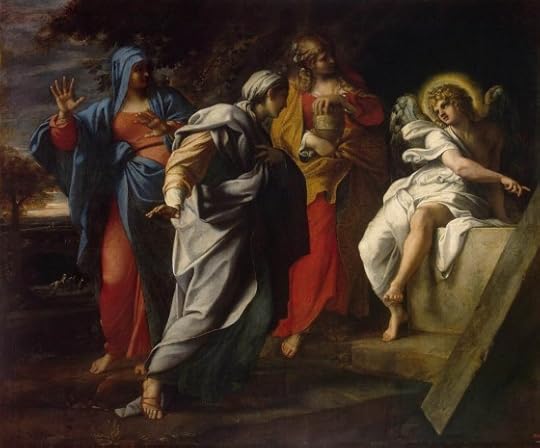
This Sunday is Palm Sunday, the beginning of Holy Week.
In our book The Final Days of Jesus Andreas Köstenberger and I try to provide some help in understanding the identity and role of Jesus’s female disciples, especially with respect to their discovery of the empty tomb and their eyewitnesses testimony to the risen Christ.
There are a number of things about the narrative of the women that can perplexing when we seek to harmonize their actions across the four accounts. The sheer number of Marys sometimes adds to the confusion! And it even can be difficult to untangle the Greek grammar. For example, is John 19:25 about three women or four?
A. “[1] his mother and [2] his mother’s sister, [that is,] Mary the wife of Clopas, and [3] Mary Magdalene”
{or}
B. “[1] his mother and [2] his mother’s sister, [3] Mary the wife of Clopas, and [4] Mary Magdalene”
Under option A, the reference is likely to Salome (which would make the sons of Zebedee—James and John—the cousins of Jesus). However, option B is more likely, meaning that Mary the wife of Clopas is Mary’s sister (or sister-in-law) and thus Jesus’s aunt.
We don’t pretend to offer definitive solutions in our book, but I thought it might be helpful for those preaching or thinking through this material to highlight the relevant entries in our reference guide at the end of the book. There is more information on these important women than we have often recognized.
1. Joanna (wife of Chuza)
Among the first women to discover the empty tomb (Luke 24:10), she was the wife of Chuza, the household manager or steward of King Herod Antipas (Luke 8:3).
She was a follower of Jesus and helped to provide financially for Jesus’s ministry, along with Susanna and many others (Luke 8:3).
2. Mary Magdalene
A Galilean woman probably from the town of Magdala (on the west bank of the Sea of Galilee). Jesus delivered her from seven demons (Luke 8:2; Mark 16:9).
She became a follower of Jesus (Matt. 27:57), a witness to the crucifixion and burial (Matt. 27:61; 28:1; Mark 15:40, 47; John 19:25), and was among the women who went to the tomb on Sunday (Mark 16:1; John 20:1).
She was the first person to see Jesus alive (Mark 16:9) and told the other disciples (Luke 24:10; John 20:18).
3. Mary (mother of Jesus, widow of Joseph of Nazareth)
She gave birth to Jesus, raised him, was present at his execution and burial, and witnessed his resurrection life.
From the cross Jesus entrusted his widowed mother to John’s care, and she went to live in his home ( John 19:25-27)—perhaps because Mary’s other sons were not yet believers ( John 7:5; see also Matt. 13:57; Mark 3:21, 31; 6:4).
Mary’s other sons (Matt. 13:55; Mark 6:2-3; Acts 1:14; 1 Cor. 9:4-5; Gal. 1:19) were named:
James (author of the biblical book of James)
Joseph/Joses
Simon
Judas/Jude (author of the biblical book of Jude)She also had at least two daughters (Mark 6:3).
4. Mary (mother of James and Joses/Joseph)
A witness of Jesus’s crucifixion, burial, and resurrection appearances.
Her sons were named James the Younger (hence her husband must have been named James) and Joses/Joseph. See Matt. 27:61; 27:56; Mark 15:40, 47.
The fact that two Marys in the story have sons with the same names (James and Joseph/Joses) shows the commonality of certain names in first-century Galilee. The name Mary, in particular, was exceedingly common in first-century Palestine, hence the need to distinguish between different Marys in the Gospels, whether by way of their hometown (Mary Magdalene) or in association with their husband (Mary of Clopas) or sons (Mary mother of James and Joses).
5. Mary (wife of Clopas)
A Galilean witness of Jesus’s crucifixion, she may be identified as Jesus’s “mother’s sister” ( John 19:25)—though see discussion under Salome below.
According to Hegesippus, as quoted by the historian Eusebius, Clopas was the brother of Joseph of Nazareth (Hist. Eccl. 3.11; 3.32.6; 4.22.4). If so, Mary and Clopas were Jesus’s aunt and uncle. Their son Simeon (Jesus’s cousin) became a leader of the Jerusalem church succeeding James the brother of Jesus.
6. Salome (mother of James and John)
One of Jesus’s female followers in Galilee, she witnessed the crucifixion and went to the tomb on Sunday (Mark 15:40; 16:1).
The parallel passage in Matthew 27:56 makes it likely that she is the mother of the sons of Zebedee (i.e., James and John).
Logic on Fire: The Life & Legacy of Martyn Lloyd-Jones
If you preorder a digital download of this film by midnight (Central Time) tonight (Friday, April 11, 2014), you will be entered to win Lloyd-Jones’s complete 14-volume commentary set on Romans (which retails for $369).
Here is some more information on the project from Jonathan Catherwood, president of the MLJ Trust and grandson of the Doctor.
Dear Friend,
We wanted to let you know about some exciting news. A Christian filmmaker called Matthew Robinson is making a documentary on Martyn Lloyd-Jones entitled “Logic on Fire: the Life and Legacy of Dr. Martyn Lloyd-Jones.” The website for the film is http://www.logiconfire.org. News of the film was announced at this week’s “Together for the Gospel” gathering in Kentucky, right before a panel on the influence of Martyn Lloyd-Jones on the evangelical community.
Matt and his team have already started filming interviews with Christian leaders such as Iain Murray (who wrote the authorized two volume biography on Dr. Lloyd-Jones [see here]), and will in Britain later this month interviewing members of the Lloyd-Jones family and visiting key locations in the life of Dr. Lloyd-Jones in England and Wales. The film is due for release in 2015.
We also wanted to let you know that while we are very excited about this project, and have greatly appreciated the care that Matt has taken to make sure that Dr. Lloyd-Jones’s descendants and the Trust are comfortable with his approach, this is an independent venture. The MLJ Trust is not funding the film and will not be receiving any proceeds from it. Our mission is to make the 1,600 audio sermons of Dr. Lloyd-Jones available at MLJTrust.org for anyone who wants them at no cost, and that is where all our efforts and resources are focused. Our hope is that interest in the film will lead to interest in the Gospel message contained in all of Dr. Lloyd-Jones’s sermons.
Every blessing to you,
Jonathan Catherwood
President; MLJ Trust
April 9, 2014
Gay Marriage: Not Just a Social Revolution but a Cosmological One
Rod Dreher has an important essay on “Sex After Christianity.”
Here is an excerpt:
Conservative Christians have lost the fight over gay marriage and, as we have seen, did so decades before anyone even thought same-sex marriage was a possibility. Gay-marriage proponents succeeded so quickly because they showed the public that what they were fighting for was consonant with what most post-1960s Americans already believed about the meaning of sex and marriage. The question Western Christians face now is whether or not they are going to lose Christianity altogether in this new dispensation.
Too many of them think that same-sex marriage is merely a question of sexual ethics. They fail to see that gay marriage, and the concomitant collapse of marriage among poor and working-class heterosexuals, makes perfect sense given the autonomous individualism sacralized by modernity and embraced by contemporary culture—indeed, by many who call themselves Christians. They don’t grasp that Christianity, properly understood, is not a moralistic therapeutic adjunct to bourgeois individualism—a common response among American Christians, one denounced by Rieff in 2005 as “simply pathetic”—but is radically opposed to the cultural order (or disorder) that reigns today.
They are fighting the culture war moralistically, not cosmologically. They have not only lost the culture, but unless they understand the nature of the fight and change their strategy to fight cosmologically, within a few generations they may also lose their religion.
“The death of a culture begins when its normative institutions fail to communicate ideals in ways that remain inwardly compelling,” Rieff writes. By that standard, Christianity in America, if not American spirituality, is in mortal danger. The future is not foreordained: Taylor shares much of Rieff’s historical analysis but is more hopeful about the potential for renewal. Still, if the faith does not recover, the historical autopsy will conclude that gay marriage was not a cause but a symptom, the sign that revealed the patient’s terminal condition.
Where Did Christian Art Come From?

Robert Louis Wilken:
Before the early third century there is no evidence of Christian art. Some have argued that in the early years Christians were aniconic—opposed to religious pictures, hostile to artistic representation of biblical events and persons. But that view has been abandoned by scholars. Though there is no archaeological evidence of Christian art before the catacomb of Callixtus, from literary sources we know that by the end of the second century Christians had begun to find ways to give visible expression to their beliefs. Clement, a Christian scholar in Alexandria, said that Christians purchased objects engraved with symbols.
Let our seals [for example, a precious stone with a designed engraved on it] be a dove or a fish or a ship running in fair wind or a musical lyre such as the one Polycrates [ruler of the Greek island of Samos in the sixth century B.C.] used or a ship’s anchor such as the one Seleucus [a Hellenistic king in Antioch in Syria who died in 281 B.C.] had engraved on his sealstone. And if someone is fishing he will call to mind the apostle [Peter]. . . . We who are forbidden to attach ourselves to idols must not engrave the face of idols [on our rings], or the sword or the bow, since we follow the path of peace, or drinking cups, since we are sober. Many licentious people carry images of their lovers and favorite prostitutes on their rings. [Paed. III.59.2-III.60.1]
Clement’s point is this: If a Christian wished to have a ring that expressed his faith he should go to a craftsman whose stones were engraved with figures that could be given a Christian meaning. What he says about rings would apply equally to other objects, such as an oil lamp, or a bowl, or a pitcher. As yet there were not Christian artists or craftsmen who designed objects with distinctive Christian images. So Clement recommends that Christians buy rings that were in common use and readily available in workshops in the markets of the city. Though they may me stamped with symbols that bear one meaning to the maker and to most buyers, some of the engravings could be given a Christian sense. A dove could be taken to symbolize the Christian virtues of gentleness and peacefulness; a fish could be a symbol of Christ because the letters of the Greek word for fish (ixthus) could be taken to spell the first letters of the words JESUS CHRIST SON OF GOD SAVIOR; a ship could signify the Church carrying the faithful over the turbulent waters of life; a young man with a lyre could depict David singing the psalms; an an anchor could be a symbol of hope (Hebrews 6:18-19).
—Robert Louis Wilken, The First Thousand Years: A Global History of Christianity (New Haven/London: Yale University Press, 2012), 49.
April 8, 2014
10 Key Events: Fundamentalism and Evangelicalism in 20th Century America
In 19th century North America, evangelicalism basically referred to a loosely associated, intradenominational coalition of Protestants who held to the basic reformational doctrines of sola fide [faith alone] and sola scriptura [Scripture alone], mediated through the revival experiences of the Great Awakenings.
David Bebbington’s evangelical quadrilateral—namely, that the common denominator among evangelicals is the combined belief in biblical authority, cruciformity, conversionism, and evangelism—has value but lacks specificity when applied to the North American experience (instead of just evangelicalism in Great Britain). North American evangelicals not only believed in the Bible’s general authority but also its inerrancy and infallibility. They not only believed in conversion but also saw revivalism as a way in which God might work.
The following are ten key events that took place in the relationship between evangelicals, fundamentalists, modernists, and neo-evangelicals during the 20th century in North America.
1. The Fundamentals (1910-1915)
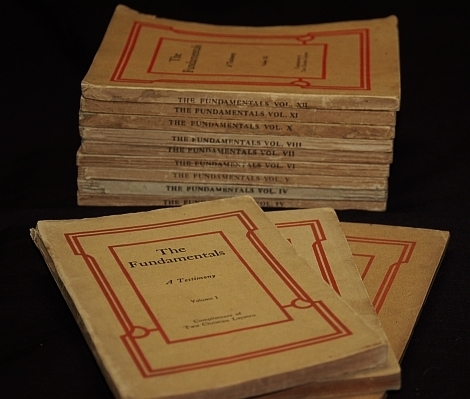
In the wake of late 19th century Darwinian evolutionary theory and with the concomitant rise of biblical higher criticism in the early 20th century, two wealthy businessmen (oil man Lyman Stewart [1840-1923] and his brother Milton] funded a 12-volume series on The Fundamentals: A Testimony to the Truth (1910-1915). These 90 essays were written by 64 English and American pastors and theologians, most of them denominational evangelicals, setting forth what they agreed were the “fundamentals” of the faith. Between 2 to 3 million copies were distributed.
2. The Term “Fundamentalism” Is Coined (1920)
In 1919, the World Christian Fundamentals Association was founded, led by William Bell Riley (1861-1947), a Minneapolis pastor who also founded Northwestern Bible College and would later be known as ”The Grand Old Man of Fundamentalism.”
In 1920, Baptist journalist Curtis Lee Laws (1868-1946) wrote an editorial (“Convention Side Lights,” Watchman-Examiner 8 [July 1, 1920]: 834) offering new nomenclature to capture the current state of conservative dissent.
The label conservatives, he wrote, “is too closely allied with reactionary forces in all walks of life.” Premillennialist ”is too closely allied with a single doctrine and not sufficiently inclusive.” Landmarkers “has a historical disadvantage and connotes a particular group of radical conservatives.”
In its place he suggests “that those who [1] still cling to the great fundamentals and who [2] mean to do battle royal for the fundamentals shall be called ‘Fundamentalists.’” In other words, they were the type of people willing to continue the fight for the sort of truths laid out in The Fundamentals pamphlets, the type of people who were joining the World Christian Fundamentals Association.
Refining the Definition
Following Laws’s original usage and utilizing the excellent analysis of Nathan Finn, fundamentalism, in its broadest and original sense (encompassing the disparate parties that would emerge), can be defined as conservative Protestant dissent against progressive (or revisionist, or Modernist, or Liberal) doctrine and mores. Those in the crossfires of fundamentalist so-called militancy were those who advocated:
progressivist beliefs that undermined the fundamentals doctrines (e.g., naturalistic evolution, biblical criticism, later neo-orthodoxy), and
progressivist values that undermined the fundamentalist understanding of the Christian life (e.g., dancing, drinking, gambling for some; others would focus more upon political movements like communism in the 1950s, or upon sexual mores, especially into the 1960s).
3. Denominational Battles Fought in the North (1919-1937)
From 1919-1937 a series of denominational battles were fought in the northern states for control of the Northern Baptist and the Northern Presbyterian denominations. Fundamentalist-evangelicals were committed denominationalists who were ecumenically minded toward those who held to the fundamentals but fought for the purity and integrity of their ecclesiastical bodies. During this time, conservative Presbyterians on several occasions sought to produce statements identifying the minimal core of their evangelical convictions: namely,
the inerrancy of the Word of God in its original autographs
the virgin birth of Jesus Christ
his vicarious atonement for sin
his bodily resurrection from the dead
the reality of biblical miracles
Others would later want to add additional items to the list like belief in the premillennial return of Christ.
4. Fosdick Preaches, “Shall the Fundamentalists Win?” (1922)
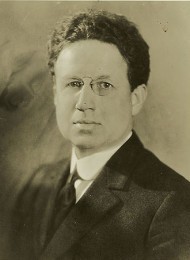 On May 21, 1922, Rev. Harry Emerson Fosdick (1878-1969) preached a provocative sermon to the First Presbyterian Church in New York City, entitled “Shall the Fundamentalists Win?” Referring to himself as an evangelical, he sounded a warning against the anti-modernistic obscurantism and anti-intellectualism of the fundamentalists. They could believe what they wanted about the virgin birth, the inspiration of Scripture, and their understanding of the atonement, but their boundary-drawing was a danger to the church and must be firmly resisted. He called for increased tolerance of spirit—though it seemed he mainly wanted the tolerance to be a one-way street toward his brand of modernism. Fosdick understood modernism to be the spirit of the age, and he viewed Christianity as needing to accommodate its categories and to infuse it with a Christian ethic of love.
On May 21, 1922, Rev. Harry Emerson Fosdick (1878-1969) preached a provocative sermon to the First Presbyterian Church in New York City, entitled “Shall the Fundamentalists Win?” Referring to himself as an evangelical, he sounded a warning against the anti-modernistic obscurantism and anti-intellectualism of the fundamentalists. They could believe what they wanted about the virgin birth, the inspiration of Scripture, and their understanding of the atonement, but their boundary-drawing was a danger to the church and must be firmly resisted. He called for increased tolerance of spirit—though it seemed he mainly wanted the tolerance to be a one-way street toward his brand of modernism. Fosdick understood modernism to be the spirit of the age, and he viewed Christianity as needing to accommodate its categories and to infuse it with a Christian ethic of love.
5. The Scopes Monkey Trial Becomes a Symbol (1925)

In 1925 the so-called Scopes Monkey Trial transfixed the nation as the ACLU orchestrated a trial of John Thomas Scopes (1900-1970), a young biology teacher willing to test the state laws on the teaching of evolution. The trial pitted famed defense attorney Charles Darrow (1857-1938) against the charismatic prosecutor William Jennings Bryan (1860-1925), a progressivist politician who was a confident fundamentalist in biblical doctrine.
Through the combination of acerbic reporting by H.L. Mencken (1880-1926), unforced errors by Bryan, and (later) a historically inaccurate play and Hollywood movie, the trial would eventually become symbolic in American culture for fundamentalism’s mean-spirited anti-intellectualism and even buffoonery.
(For more on the history of the trial, go here.)
6. Machen Defends the Faith against Modernism (1929-1937)
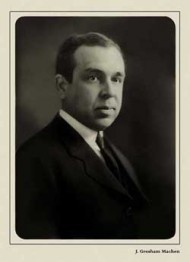 In 1929, J. Gresham Machen (1881-1937)—a brilliant Reformed New Testament professor at Princeton Theological Seminary, who had studied under Adolf Schlatter in Germany—left the school after it reorganized its curriculum, having opened the door (in Machen’s view) to modernist compromise. He would then found Westminster Theological Seminary (1929) and later The Orthodox Presbyterian Church (1936) after he was tried and found guilty for continuing his Independent Board for Presbyterian Foreign Missions (IBPFM), designed so that money contributed by orthodox Presbyterians would end up going to support likeminded orthodox Presbyterian missionaries rather than modernist Presbyterians like Pearl Buck (1892-1973).
In 1929, J. Gresham Machen (1881-1937)—a brilliant Reformed New Testament professor at Princeton Theological Seminary, who had studied under Adolf Schlatter in Germany—left the school after it reorganized its curriculum, having opened the door (in Machen’s view) to modernist compromise. He would then found Westminster Theological Seminary (1929) and later The Orthodox Presbyterian Church (1936) after he was tried and found guilty for continuing his Independent Board for Presbyterian Foreign Missions (IBPFM), designed so that money contributed by orthodox Presbyterians would end up going to support likeminded orthodox Presbyterian missionaries rather than modernist Presbyterians like Pearl Buck (1892-1973).
Machen was a non-dispensational example of conservative dissent. He did not particularly care for or embrace the “fundamentalist” label, but he understood that their belief in premillennialism (while in error, in his judgment) was an error of a different kind than that propagated by the modernists.
In 1923 Eerdmans published Machen’s landmark book Christianity and Liberalism, arguing that modernistic liberalism was not a sub-species of Christian orthodoxy but rather a different religion that must be rejected once and for all. For example, he wrote, that the “Church of Rome may represent a perversion of the Christian religion; but naturalistic liberalism is not Christianity at all” (p. 52).
When Machen died in 1937 at the age of 55, after a bout with pneumonia, it marked the passing of an era in 20th century fundamentalist-evangelicalism.
(The best biography of Machen is D.G. Hart’s Defending the Faith: J. Gresham Machen and the Crisis of Conservative Protestantism in Modern America; the best entry point is Stephen J. Nichols’s J. Gresham Machen: A Guided Tour of His Life and Thought.)
7. Internal Criticisms Issued within Fundamentalism (Late 1930s-Early 1940s)
By the late 1930s and early 1940s, some quarters of fundamentalism began to experience discomfort with the trajectory of the movement. There was a concern that the militancy of fundamentalism was having unfortunate results. Speaking in broad terms, some critics perceived the default posture of fundamentalism to have
a focus on infighting over soul-winning
a diminished social conscious in order to protect the doctrine of the gospel, and
a downplaying of intellectual engagement with the academy in the desire to avoid influence by modernism.
8. Ockenga and Henry Lead Fuller Seminary and Christianity Today (1941-1947)
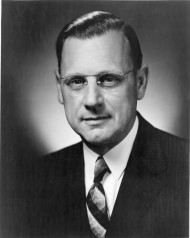 In 1941 Harold John Ockenga (1905-1985), pastor of Park Street Church in Boston and a former student of Machen’s, issued the call for “neo-evangelicalism,” and the National Association of Evangelicals was formed that year. (Carl McIntire [1906-2002] was originally to be part of this, but broke off to form his own fundamentalist association that would define itself in many ways as a corrective to and critic of neo-evangelicalism.) This group was broadly ecumenical, at first encompassing not only evangelical denominationalists but also holiness, Pentecostal groups, and independent ministries like the Salvation Army.
In 1941 Harold John Ockenga (1905-1985), pastor of Park Street Church in Boston and a former student of Machen’s, issued the call for “neo-evangelicalism,” and the National Association of Evangelicals was formed that year. (Carl McIntire [1906-2002] was originally to be part of this, but broke off to form his own fundamentalist association that would define itself in many ways as a corrective to and critic of neo-evangelicalism.) This group was broadly ecumenical, at first encompassing not only evangelical denominationalists but also holiness, Pentecostal groups, and independent ministries like the Salvation Army.
In 1947 Ockenga co-founded Fuller Theological Seminary with Charles E. Fuller (1887-1968), 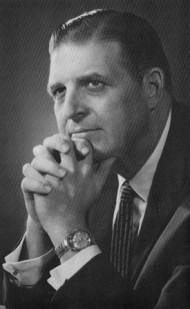 host of the popular radio broadcast “The Old-Fashioned Revival Hour.” The initial faculty—including Carl F. H. Henry (1913-2003)—were evangelical intellectuals who wanted to write a new chapter in confessional Christian higher education.
host of the popular radio broadcast “The Old-Fashioned Revival Hour.” The initial faculty—including Carl F. H. Henry (1913-2003)—were evangelical intellectuals who wanted to write a new chapter in confessional Christian higher education.
That same year Eerdmans published Henry’s The Uneasy Conscience of Modern Fundamentalism, which argued against both fundamentalists and liberals who were obscuring the gospel by focusing upon secondary issues.
In 1956 Billy Graham (1918-) founded Christianity Today, designed to be a forward-looking, positive alternative to The Christian Century. Henry was tapped as the magazine’s first editor.
9. Billy Graham and Bob Jones Separate (1957)
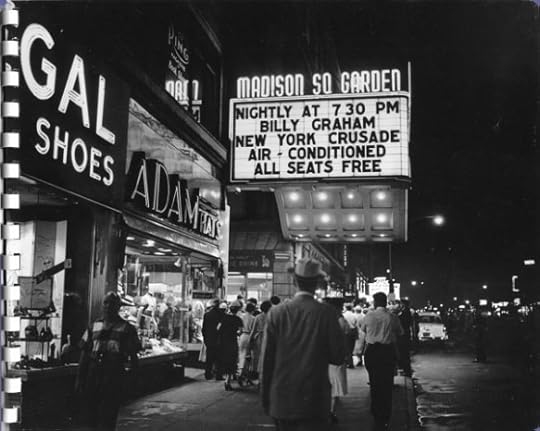
An epochal internal rift occurred in the summer of 1957, as Billy Graham engaged in his historic evangelistic crusades in Madison Square Garden with record crowds. From Graham’s perspective, he needed to partner with local pastors and churches in the area to ensure a warm reception of collegiality rather than to exacerbate competition and suspicion. This would also be a key part of the follow-up effort for those who had professed faith at the meetings. The strategy worked and Graham was not only welcomed by the local churches (many of them Modernistic) but also by the masses.
But this methodology was increasingly seen as problematic and troublesome, especially for fundamentalists in the South. Bob Jones Jr. (1911-1997), with the support of his father Bob Jones Sr. (1883-1968), founder of the eponymous Bible college, made it clear to Graham and his supporters that partnership with the modernists was a bridge too far. They felt that by having modernists on the platform—a visible endorsement, replete with asking some of them to pray and entrusting the gospel follow-up to some of their churches— Graham was engaging in sinful compromise and offering an implicit endorsement of the enemies of the faith. For the Joneses, and those who followed in their lead, this meant that they must separate not only from Graham himself, but from all those who supported Graham.
Thus emerged a new phase in the history of fundamentalist-evangelicalism, as the so-called “secondary separationists” began to have increasing influence, especially in the South. Whereas “fundamentalism” had originally been a conservative dissent movement within the denominations (working for their reform), a new segment of it defined faithfulness as leaving compromising denominations that had become apostate in their view—and also rejecting any fellowship and partnership with those who refused to do the same.
Three Approaches to Separatism
Emerging from this 1957 division, and continuing through the intra-denominational controversies of the Lutheran Church Missouri Synod and the Southern Baptist Convention into the 1980s, there was conservative agreement that personal holiness was a necessity and that separation from moral sin was required. But beneath this general principle, there were three overlapping approaches to separation within fundamentalism.
First, there were denominational reformers who believed they should stay within a denomination and fight for its doctrinal and moral purity.
Second, there were denominational separatists who believed that faithful Christians should extricate themselves from denominations and professing Christians influenced by modernism and therefore apostasy.
Third, there were ecclesiastical separatists who were also secondary separationists, refusing to have fellowship with fellow conservative dissenters who did not withdraw from apostate denominations.
What must be noted here, and is often overlooked in discussions of fundamentalism, is that the original fundamentalists were in categories 1, and sometimes 2. But category 3 was largely the result of post-1957 fundamentalism and represents a new phase of development.
10. Fuller Seminary Divides over Inerrancy on Black Saturday (1962)
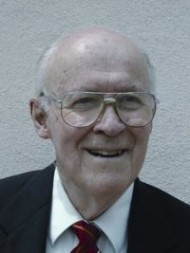 In 1962 there occurred another event that, in my view, may be the second most important development after the 1957 split. On December 1, at the conclusion of a three-day planning retreat for the faculty and trustees of Fuller Theological Seminary, the issue of revising the school’s creedal statement on inerrancy was on the agenda. Ockenga, the school’s president in absentia who had helped to draft the original informal statement in a Reformational-Princetonian direction, wondered why the creed needed to be revised in the first place.
In 1962 there occurred another event that, in my view, may be the second most important development after the 1957 split. On December 1, at the conclusion of a three-day planning retreat for the faculty and trustees of Fuller Theological Seminary, the issue of revising the school’s creedal statement on inerrancy was on the agenda. Ockenga, the school’s president in absentia who had helped to draft the original informal statement in a Reformational-Princetonian direction, wondered why the creed needed to be revised in the first place.
Daniel P. Fuller (1925) was the only child of the school’s founders, Charles and Grace Fuller. He had long abandoned his father’s dispensationalism, and had gone off to get a second doctorate in Basel with serious doubts about inerrancy—doubts that were solidified in his studies with Oscar Cullmann and after a conversation with a former fellow Fuller student who had gone on for a PhD at Harvard and expressed his opinion that Fuller would not survive if it retained its outmoded fundamentalist doctrine of inerrancy. Fuller informed Ockenga that the Bible did contain errors on non-revelational details (observable but not essential matters) and that an appeal to the original autographs would not solve the problem. Fuller’s nuanced view—which had much to do with the hermeneutics of authorial intent and accommodation—sought to retain the term “inerrancy” because he thought every word of Scripture was inspired by God and inerrant in its purposes, but it was clear he was breaking with the historic Warfieldian-Princetonian understanding.
The progressive-conservative divide was exacerbated and solidified and between the faculty—between those who were more comfortable with a traditional understanding of inspiration and those who wanted more progressivist changes. “Black Saturday” forever changed the direction of the school and stands for a significant change in the relationship between fundamentalism and neo-evangelicalism, as progressive evangelicalism proffered itself as a new third way.
(The story is told from a critical perspective in Harold Lindsell’s The Battle for the Bible, though it has a number of historical errors in recounting the story. The fullest version by a celebrated historian is George Marsden’s Reforming Fundamentalism: Fuller Seminary and the New Evangelicalism.)
Livestream for T4G: April 8-10, 2014
You can register to watch the T4G livestream online for free.
All times below are Eastern. When each plenary speaker is speaking has not been publicly announced. At the end of the post you can find the list of panels, but again it has not been announced when each will be.
I am not sure if they are able to stream the music, so if it’s not live you may want to check back 20 minutes into the session.
Tuesday, April 8
1:00 – 2:50 | General Session 1
3:05 – 4:10 | General Session 2
4:30 – 5:15 | Panel 1
7:30 – 8:55 | General Session 3
9:10 – 9:55 | Panel 2
Wednesday, April 9
9:00 – 10:25 | General Session 4
10:40 – 11:45 | General Session 5
12:00 – 12:30 | Panel 3
3:00 – 4:00 | Breakout Sessions
7:30 – 8:50 | General Session 6
9:05 – 9:45 | Panel 4
Thursday, April 10
9:00 – 10:25 | General Session 7
10:40 – 11:45 | General Session 8
12:00 – 12:30 | Panel 5
2:00 – 3:15 | Panel 6
3:45 – 5:00 | General Session 9
Plenary Speakers:
Ligon Duncan, The Gospel by Numbers (Numbers 5)
Albert Mohler, The Open Door is the Only Door: The Singularity of the Gospel in a Pluralistic Age (Acts 4)
Mark Dever, The Certain Victory of Christ’s Church an Encouragement to Evangelism (Isaiah 36-37)
John MacArthur, Mass Defection: The Great Physician Confronts the Pathology of Counterfeit Faith (John 6)
David Platt, Relenting Wrath: The Role of Desperate Prayer in the Mystery of Divine Providence (Exodus 32)
John Piper, Persuading, Pleading and Predestination: Human Means in the Miracle of Conversion
Kevin DeYoung, Never Spoke a Man Like This Before: Inerrancy, Evangelism and Christ’s Unbreakable Bible (John 10:35)
Thabiti Anyabwile, The Happiness of Heaven in the Repentance of Sinners (Luke 15)
Matt Chandler, Christ is All (2 Tim. 1:8-14)
Panels:
“D. Martyn Lloyd-Jones: Pastor-Evangelist”
Chair: Mark Dever
Panelists: John MacArthur and Iain Murray (biographer of D. Martin Lloyd Jones)
“Homosexuality: Our Third Rail?”
Chair: Albert Mohler
Panelists: Russell Moore and Sam Alberry (author of Is God Anti-gay?)
“Preaching Sanctification”
Chair: Matt Chandler
Panelists: Kevin DeYoung, John Piper, David Platt, and Derek Thomas (Senior Minister of First Presbyterian Church, Columbia, SC)
“Denominations: Your Grandfather’s Oldsmobile?”
Chair: Ligon Duncan
Panelists: Mark Dever, Kevin DeYoung, and John Yates (Rector of The Falls Church Anglican in Falls Church, VA)
“Stump the Panel”
Chair: Mike McKinley
Panelists: Ligon Duncan, Albert Mohler, Mark Dever, Thabiti Anyabwile, and Simon Gathercole
“Future Theological Threats“
Chair: Mark Dever
Panelists: Ligon Duncan, Albert Mohler, Kevin DeYoung, Simon Gathercole, and Peter Williams
April 7, 2014
At What Point in Pilgrim’s Progress Does Christian Get Saved?
I have to admit that I have always found this a confusing aspect of John Bunyan’s Pilgrim’s Progress. Charles Spurgeon expressed his one disagreement with Bunyan in this way: “If he meant to show what usually happens, he was right; but if he meant to show what ought to have happened, he was wrong.”
I am thankful that Jim Orrick, professor of literature and culture at Boyce College (Louisville), was willing to let me post his answer to this question.

Painting by Mike Wimmer
When I ask this question to my students who have just finished reading the book, they nearly always respond with a variety of answers. After batting around several ideas, we narrow the possibilities down to two: Christian was saved either (1) when he entered through the Wicket Gate or he was saved (2) when his burden rolled off his back at the cross.
Most students come to the conclusion that Christian got saved at the cross.
But this is, in fact, the wrong answer. Christian got saved when he entered through the Wicket Gate.
Students get the wrong answer because they misunderstand three critical elements of Bunyan’s allegory: (1) The Wicket Gate, (2) Christian’s Burden, and (3) the proper object of saving faith.
1. The Wicket Gate
First, a wicket gate is a small or narrow gate, and in the Bible, Jesus identifies himself as the narrow gate, so in Pilgrim’s Progress the Wicket Gate represents Christ. In Pilgrim’s Progress, when Christian asks Evangelist “Whither must I fly?” Evangelist directs Christian to the Wicket Gate, or to Christ, and not to the cross. The Wicket Gate represents Christ.
2. Christian’s Burden
A second error results because my students usually misunderstand what the burden on Christian’s back represents. When we meet him, Christian has an enormous burden on his back, and Christian’s burden represents not sin per se, but it represents the shame and doubt that he feels because of his sin. Christian’s sins get forgiven, and he was justified when he received Christ, which is represented by his entering the Wicket Gate. But Christian does not yet understand the basis of his forgiveness, so his conscience continues to bother or burden him. Put in more technical terms (always a welcome means of clarification) the burden represents psychological guilt not forensic guilt. Therefore, what Christian loses at the cross is his shame and doubt caused by sin, because his sins had already been forgiven when he entered the Wicket Gate. Also, at the cross Christian receives a scroll, which he later calls his assurance. When Christian entered the Wicket Gate, he received Christ. When Christian gazed at the cross, he understood substitutionary atonement and imputed righteousness, and this gave him assurance that his sins were forgiven.
This understanding of Christian’s salvation in Pilgrim’s Progress parallels Bunyan’s own experience as he describes it in his spiritual autobiography, Grace Abounding to the Chief of Sinners. There he informs us that for many months after his conversion he was tormented by deeply unsettling questions about his salvation, but all these questions were put to rest when he came to understand imputed righteousness.
So Christian was saved the moment he entered the Wicket Gate and that was before he came to the cross.
3. The Proper Object of Saving Faith
This paves the way for us to think about the third error my students sometimes make, they are confused about the proper object of saving faith.
“Are you saying that someone can be saved without the cross?” a concerned student asks.
“No,” I answer, “No one can be saved apart from what Jesus accomplished on the cross, but the Bible proclaims that a person gets saved when he receives Christ, and the Bible does not say that a person gets saved through believing that Jesus died for him. Christ himself is the proper object of saving faith, not some part of his work.”
This is a reflective moment for most, because in these days, virtually everyone has been told that if he will believe that Jesus died for him, he will be saved, but I repeat: this is not found in the Bible. A person is saved not when he believes in right doctrine (substitutionary, penal atonement, in this case) but a person is saved when he believes in the right person, namely Christ. So the object of saving faith is not a doctrine but a person. Christ himself is the treasure chest of salvation. Receive him, and you receive all that is in him. The doctrine of substitutionary, penal atonement is an indispensable, essential component of the gospel, but it is not the whole gospel. How many Christians understood this crucial doctrine when they first received Christ? Nearly none! So how could they have been saved? Because, in spite of having underdeveloped or even mistaken ideas about the nature of the atonement, all who receive Christ the risen Lord as Lord and Savior are saved.
If you want some help reading the great classic, Leland Ryken has just published a short guide through Crossway.
April 4, 2014
PBS Looks at New Calvinism
PBS’s Religion & Ethics Newsweekly recently looked at “New Calvinism,” with a focus on the Southern Baptist Convention.
You can read the transcript or watch the video below:
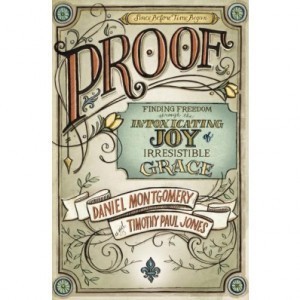 Among those featured in the short profile is Daniel Montgomery, founding pastor of Sojourn Community Church in Louisville and cofounder of the Sojourn Network.
Among those featured in the short profile is Daniel Montgomery, founding pastor of Sojourn Community Church in Louisville and cofounder of the Sojourn Network.
He is the co-author (with Dr. Timothy Paul Jones) of the forthcoming book, PROOF: Finding Freedom through the Intoxicating Joy of Irresistible Grace (Zondervan, due out in May 2014).
Reformation 101
Below is the opening talk from Steve Nichols’s series of Reformation Profiles, where he looks at the solas of the Reformation through the various Reformers:
Sola Scriptura: Martin Luther and the Rediscovery of the Authority of Scripture
Sola Gratia: Ulrich Zwingli and the Rediscovery of Grace
Sola Fide: Lady Jane Grey and the Rediscovery of Justification by Faith
Sola Christus: John Calvin and the Blessing of Christ Alone
Soli Deo Gloria: Glorifying God in Everything
Q&A
And here are some other helpful entry points into understanding the reformation that changed the church, and the world.
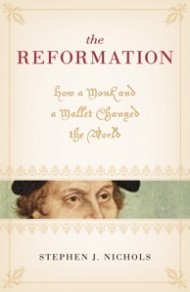 Stephen J. Nichols,
The Reformation: How a Monk and a Mallet Changed the World.
Stephen J. Nichols,
The Reformation: How a Monk and a Mallet Changed the World.
Read for free the table of contents, the introduction and chapter 1, as well as chapter 6.
“Professor Stephen Nichols is already well-known for his remarkable ability to make history live and sing. This new work is no exception and will simply enhance his well-deserved reputation. It is a scintillating helicopter tour of the amazing men—and wonderful women—of the Reformation. Here conviction joins with courage, holiness with humor, in a wonderful medley of Christian heroes and heroines.”
—Sinclair B. Ferguson
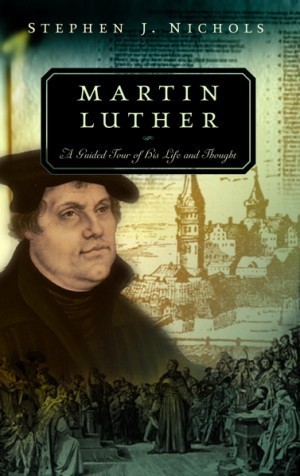 Stephen J. Nichols, Martin Luther: A Guided Tour of His Life and Thought
Stephen J. Nichols, Martin Luther: A Guided Tour of His Life and Thought
Read for free the table of contents, preface, and introduction.
J. I. Packer: “For half a century, Bainton’s Here I Stand has been the best introduction to Luther. Stephen Nichols’s engaging volume is in many ways better than Bainton’s for this purpose. It deserves to be widely read.”
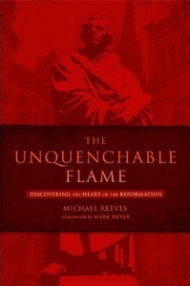 Michael Reeves, The Unquenchable Flame: Discovering the Heart of the Reformation.
Michael Reeves, The Unquenchable Flame: Discovering the Heart of the Reformation.
Read for free the table of contents, Mark Dever’s foreword, and chapter 1.
“With the skill of a scholar and the art of a storyteller, Michael Reeves has written what is, quite simply, the best brief introduction to the Reformation I have read. If you’ve been looking for a book to help you understand the Reformation, or just to begin to study church history, this little book brings history to life.”
—Mark Dever
 Kirsten Birkett, The Essence of the Reformation.
Kirsten Birkett, The Essence of the Reformation.
In addition to Dr. Birkett’s overview of the Reformation, this book includes excerpts from classic works by Luther, Calvin, and Crammer.
Read for free the preface, the table of contents, all of part 1, and portions from the classics.
“I do not know any book that more succinctly gets across, in readable prose, what the Reformation was about. This new edition combines Birkett’s superb text with some judiciously selected primary documents. This is a book to distribute widely among lay leaders and other Christians who want to be informed of the heritage of the gospel that has come down to us.”
—D. A. Carson
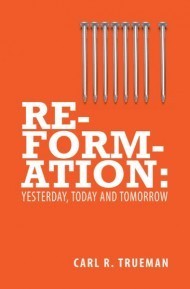 Carl R. Trueman, Reformation: Yesterday, Today, and Tomorrow
Carl R. Trueman, Reformation: Yesterday, Today, and Tomorrow
“This fine book should be required reading for all Christians—and especially for those who doubt whether the Protestant Reformation has anything left to say to us in our day. Stating that “the Reformation represents a move to place God as he has revealed himself in Christ at the centre of the church’s life and thought,” Trueman then retrieves Luther’s theology of the cross, argues that because the Reformation “was above all a movement of the Word—incarnate in Christ and written down in the Scriptures,” and because the Spirit works through the Word, “the Word written and the Word preached are both central to Christianity and are not simply cultural forms which can be shed when culture moves on,” and then closes with a chapter on Christian assurance that recognizes our assurance as the foundation for our Christian activity. Along the way, he scatters nugget after nugget of insight into what is core to the Reformation legacy, motivating his readers to embrace this core again.”
—Mark R. Talbot
Kevin DeYoung’s New Book: “Taking God at His Word”
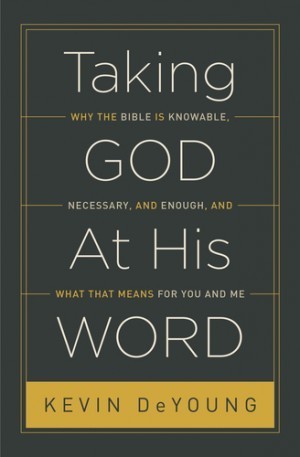 Kevin DeYoung’s outstanding new book, Why the Bible Is Knowable, Necessary, and Enough, and What That Means for You and Me (Crossway, 2014), is now available.
Kevin DeYoung’s outstanding new book, Why the Bible Is Knowable, Necessary, and Enough, and What That Means for You and Me (Crossway, 2014), is now available.
WTS has the book on sale for 44% off (for a total of $10 for the hardcover book). If you purchase 5 or more copies, they are 56% off ($8.00 each). And they even have a bulk discount for 61% off.
Here’s the free study guide for the book. And here are some endorsements:
“My trust in God’s Word is greater, my submission to God’s Word is deeper, and my love for God’s Word is sweeter as a result of reading this book. For these reasons, I cannot recommend it highly enough.”
—David Platt, Senior Pastor, The Church at Brook Hills, Birmingham, AL; author, Radical: Taking Back Your Faith from the American Dream
“This little book is a highly readable introduction to Scripture’s teaching about Scripture that preserves the contours of a responsible and informed doctrine of Scripture, without getting bogged down in arcane details. Buy this book by the case and distribute copies to elders, deacons, Sunday school teachers, and anyone in the church who wants to understand a little better what the Bible is. Bad doctrine springs in part from ignorance. Blessed are those teachers and preachers in the church who, like the author of this book, combat ignorance by getting across mature theology in a lucid style that avoids generating theological indigestion.”
—D. A. Carson, Research Professor of New Testament, Trinity Evangelical Divinity School
“One of my prayers for the next twenty years of ministry, if the Lord sees fit to grant me that, is that we might see the level of biblical literacy exponentially grow. For that to happen we must learn what the Scriptures are and how heavily we can lean on them. Kevin DeYoung serves this end well in Taking God At His Word. May the God of the Word be known and cherished all the more because of this little book.”
—Matt Chandler, Lead Pastor, The Village Church, Dallas, TX; President, Acts 29 Church Planting Network
“This is a brilliant, succinct, yet thorough study of the authority and sufficiency of Scripture, based on what Scripture says about itself. Clarity and passion are the distinguishing marks of Kevin DeYoung’s writing, and this may be his finest, most important work yet.”
—John MacArthur, Pastor, Grace Community Church, Sun Valley, CA
“If you’re looking for a clearly and simply stated doctrine of Scripture, here it is. Kevin DeYoung has accomplished his aim of communicating what the Bible says about the Bible. He’s done it with the qualities we have come to anticipate from him: efficiency, pastoral care, wit, and rigor. Most of all, he has let the Word speak for itself.”
—Kathleen B. Nielson, Director of Women’s Initiatives, The Gospel Coalition
“This is the book that I will be handing out to those searching for true spirituality, those who want to hear a special word from God, and to those who want an improved knowledge of God. Kevin DeYoung convincingly teaches that God has adequately spoken to his people. Taking God At His Word is an accessible defense of the doctrine of Scripture, from Scripture, aiming to renew our trust and delight in God’s word.”
—Aimee Byrd, author, The Housewife Theologian
Justin Taylor's Blog
- Justin Taylor's profile
- 44 followers



